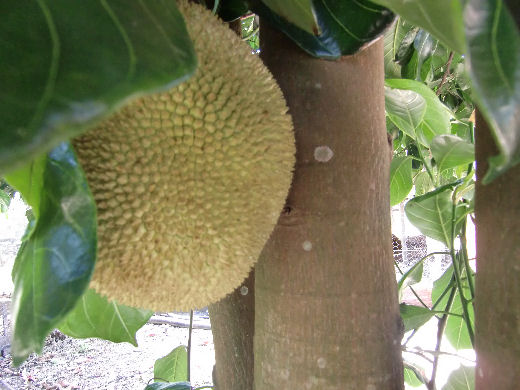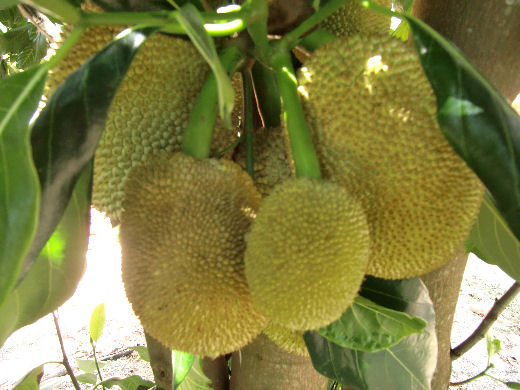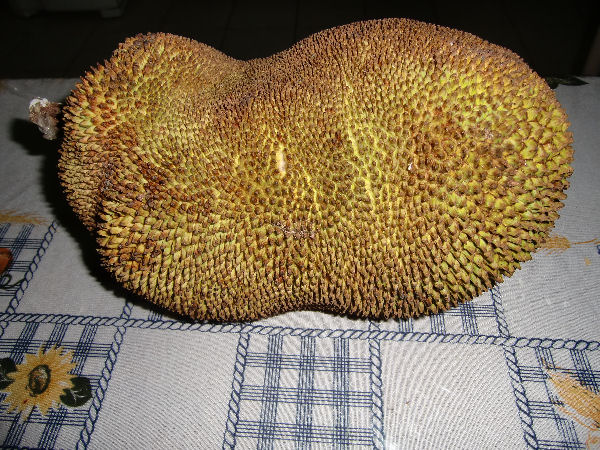

Artocarpus heterophyllus (Jackfruit Tree, Jaca)
More than 33 feet deciduous tree from the genus Artocarpus and the family Moraceae with relatively short trunk and one dense tree crown, is closely related with the breadfruit tree. The bark is darkbrown and raw, inside pinkish colored, by scarify of the bark latex will extravasate. The leaves are darkgreen, leathery, 4 to 8 inches long and eliptic-elongateliptic, stipules are existing.
Jackfruit trees are monoicous, on one tree are both female and male blossoms. The male blossoms (to 6 inches long) are sitting at cylindric stems, the female at oval to elongate stems. The fruits are growing at the trunk, are differently large and covered by one yellowish-greenish hard skin with small pimples. The fruits grow very large, 1 2/3 to 3 feet long with a diameter of 1 to 1 2/3 feet, yellowish green at conical tubercles and can weight to approx. 20 kg, the jackfruit is the world's largest fruit and belongs to the popularest kinds of fruit. They are ripening during the rainy season. The seeds of the jackfruit are oval bean-shaped, 1 to 1.5 inches long and covered by one yellowish skin. The fibrous pulp is sweetish-juicy, of yellow to light violet color with one taste like the of bananas with musky aromatic and separated in approx. palm-like bag-like gaps. The in one large amount inside distriubuted seeds are tasting like chestnuts and are eaten in-natura, cooked or dried. The inedible fibers which are covering the pulp extravaste one sticky secretion, which cannot removed by water but by oil from the skin.
The wood is resistant against termites and mahogany-like, this makes the jackfruit tree as timber tree also interesting beside of the use in the agriculture. In Brazil the jackfruit is also named "Jaca", it is also grown in Brazil, of all in Southern Asia and India. In Thailand it is believed as one mojo, if it is planted into the own garden. The jackfruit tree foods poor people, the huge fruits are nutritious, the Indian government lets to plant jackfruit trees at highways and rivers and also forestation programs are existing in India with the jackfruit. We have 3 jackfruit trees in our yard and also have already sown in-situ.with success.
One of our jackfruit trees bore 9 fruits in 2010! We could harvest one jackfruit and it was our first own jackfruit harvest! Even after less than 2 years after the frost in the year of 2011 with -2°C the both larger of our 5 jackfruit trees bore fruited again, some of them we could eat. The trees did recover quickly, but all of the in the nursery of Helton Josué in Angatuba have died completely, Helton had to cut and remove them and plant new trees, in his nursery the frost damages were more severe, there it was a bit colder.

One of our jackfruit trees in September 2008.

Close-up view of the foliage and the branches of Artocarpus heterophyllus (Jackfruit) in September 2008.

One typical jackfruit at the trunk in November 2010.

9 fruits of the jackfruit at a stroke in November 2010.

First jackfruit from our own harvest in November 2010.
Back to the Agricultural Plant List
Updated by Joachim Jaeck on October 12th, 2013